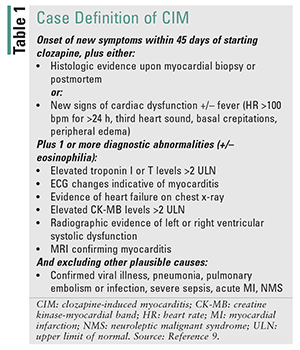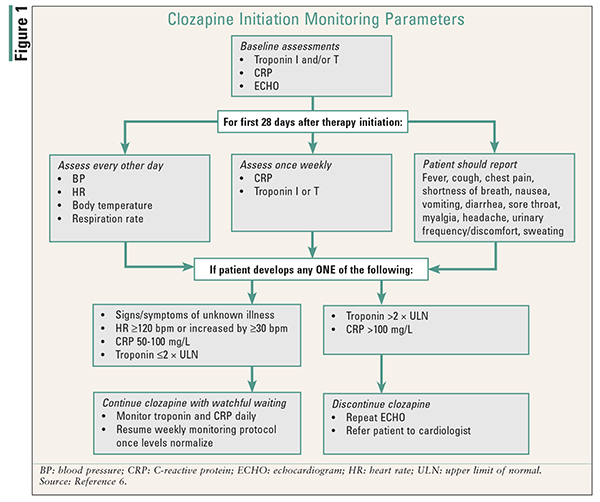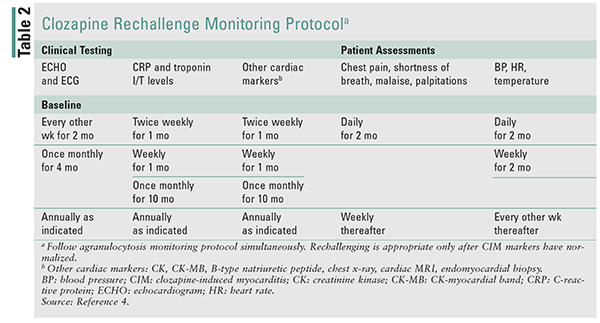US Pharm. 2018;43(11):HS2-HS7.
ABSTRACT: Clozapine’s superiority in preventing relapse, rehospitalization, and suicidality associated with treatment-resistant schizophrenia is often overshadowed by its undesirable side-effect profile. Agranulocytosis and myocarditis are rare, but potentially fatal, side effects that require immediate discontinuation of clozapine treatment. Clozapine-induced myocarditis (CIM), which has a mortality rate of 10% to 50%, commonly presents within the first month of clozapine initiation, and it can be difficult to distinguish it from a benign inflammatory response to clozapine. CIM’s varied and sometimes asymptomatic clinical presentation and the lack of reliable diagnostic markers create a clinical challenge. Recent case reports and monitoring recommendations provide guidance on reducing the mortality and morbidity associated with CIM.
Treatment-resistant schizophrenia (TRS) is a debilitating condition that affects approximately 20% of patients with schizophrenia.1 Clozapine, a second-generation antipsychotic, is the only FDA-approved agent for treating TRS.1 Its unmatched efficacy and superiority to other antipsychotics have been replicated in numerous studies since the 1980s, notably in preventing relapse, rehospitalization, and suicidal behavior in treatment-refractory patients.1,2 Yet because of its undesirable side-effect profile, which includes agranulocytosis and myocarditis, only 10% to 20% of patients who could benefit from clozapine actually receive it.3 The hesitation of clinicians and patients to initiate clozapine because of these adverse events is not unfounded, although the risk may be overestimated; for example, the implementation of mandatory blood monitoring has reduced the incidence of agranulocytosis to less than 1%.4
As noted above, myocarditis is another rare, life-threatening adverse event associated with clozapine use, and this condition can occur within the first 4 weeks of clozapine initiation.4,5 However, unlike the case with agranulocytosis, there are no widely accepted monitoring guidelines to facilitate early recognition of clozapine-induced myocarditis (CIM). This article will describe clinical characteristics, provide evidence-based monitoring parameters, and discuss the management of CIM.
Incidence
The incidence of CIM is difficult to ascertain given the possibility of underreporting, misdiagnosis, and regional differences in monitoring. A 2018 meta-analysis reported international incidence rates of 0.015% to 8.5%, with the highest rates coming from Australian health centers.5 Although it is possible that genetic differences may account for the higher number of cases in Australia, increased clinician awareness is the more likely cause. Clozapine’s manufacturer, Novartis, distributed monitoring recommendations to Australian clinicians in response to a 1999 publication that documented the first 15 cases of CIM in Australia.6 This led to an increase in the number of diagnosed and subsequently reported cases.7 The accepted estimate of worldwide incidence is around 3%.8
Prognosis
CIM has a mortality rate ranging from 10% to 50%, but the implementation of monitoring recommendations to facilitate prompt diagnosis has stabilized the number of fatalities even though the amount of reported cases has risen.5,7 Generally, patients will fully recover from CIM with no residual symptoms; in fact, cardiac function was found to normalize in 70% of patients as early as 5 days after clozapine discontinuation.9
However, severe psychosis commonly occurs after clozapine withdrawal.10 One study reported that one-half of patients who stopped clozapine experienced an abrupt deterioration in mental status and increased suicidality.4 Therefore, it is imperative to rule out other causes of myocarditis before discontinuing clozapine.
Risk Factors
Studies found an association between CIM and higher cumulative-dose exposure during clozapine titration; for this reason, it is recommended that clozapine be slowly titrated at increases of 25 mg per day over 4 to 6 weeks.5 It is also advised to avoid sodium valproate and its derivatives during initial titration based on a 2.5-fold increased risk of CIM demonstrated in a case-control study, but other studies have failed to replicate that association.4 Coronary artery disease does not appear to be a risk factor; in a 2011 review of myocarditis cases, atherosclerosis was present in only 50% of fatal cases.11
Pathophysiology
The most common cause of myocarditis is viral infection; however, hypersensitivity myocarditis occurs in response to medication.3 The mechanisms behind CIM are not completely understood, but a widely accepted theory is that a directly cardiotoxic metabolite of clozapine forms via altered metabolism and damages myocardial tissue.3 Further exacerbating myocardial injury is the increased blood concentration of catecholamines resulting from clozapine’s inhibition of the norepinephrine transporter.12 Additionally, a type 1 immunoglobulin E–mediated hypersensitivity reaction is responsible for the release of proinflammatory cytokines and inflammatory infiltrates in the heart.3,5
This hypersensitivity reaction is thought to be why patients commonly experience a mild, self-limiting, and benign systemic inflammatory response to clozapine during the initial titration period.13 Flulike symptoms, low-grade fever, eosinophilia, and elevations in C-reactive protein (CRP) and creatine kinase may occur, but these conditions fully resolve after 4 to 6 weeks of continued therapy.5,6,12
Clinical Presentation
Differentiating between the onset of a benign inflammatory response to clozapine and burgeoning CIM can be challenging.5 At the onset of myocarditis, patients usually present with nonspecific flulike symptoms such as fever, dyspnea, myalgia, gastrointestinal distress, or fatigue, but this initial presentation is highly variable, and in some cases a patient is asymptomatic.14 Symptoms of cardiac involvement, such as chest pain, peripheral edema, hypotension, and tachycardia, may not develop for several days.5 Therefore, monitoring for elevated cardiac and inflammatory biomarkers in symptomatic patients can help clinicians make a timely and accurate diagnosis.6
Diagnosis
Recognizing the need for clear diagnostic guidance, Ronaldson and colleagues published a case definition for CIM in 2010 (TABLE 1).9 Their definition, which used data from 38 cases and 47 controls, was developed to “maximize specificity at the expense of sensitivity.” Maximizing specificity would ideally prevent unnecessary discontinuation of clozapine in a mild transient illness or misdiagnosis, which could happen if diagnostic criteria were overly sensitive.9

This analysis contained several important findings. First, CIM occurred relatively soon after clozapine was initiated; in 36 of 38 cases, symptoms of CIM appeared between treatment days 14 and 22.9 Fever, eosinophilia, and tachycardia lacked sufficient specificity, but elevated CRP and troponin levels appeared to have more diagnostic utility. CRP exceeded 100 mg/L in 87% of cases and in just 14% of controls. A rise in troponin level at least twice the upper limit of normal (ULN) was seen in 86% of cases, but was absent in controls.9 Finally, a temporal association was found between elevations in biomarkers and symptom onset. CRP tended to increase at approximately the same time as the initial onset of symptoms, and troponin elevation was delayed up to 5 days after CRP peaked. If present, eosinophils increased 7 days after troponin levels peaked.9
A recent case report demonstrates the high sensitivity of combined CRP and troponin elevations in detecting CIM. In this case, a patient taking clozapine had no signs or symptoms of illness other than chest pain commencing on day 9.8 Clozapine was discontinued after a cardiac workup revealed elevated troponin of 12 mcg/L (ULN 0.03-0.6 mcg/L) and CRP of 360 mg/L (ULN 5-10 mg/L). An ECG showed ST-segment elevations. Results of cardiac catheterization revealed no coronary artery disease, thereby ruling out myocardial infarction. A transthoracic echocardiogram (ECHO) indicated decreased left ventricular function and an ejection fraction (LVEF) of 35%. All other causes of myocarditis were excluded, and lisinopril 2.5 mg daily and metoprolol tartrate 12.5 mg twice daily were initiated. Four days after discontinuing clozapine, repeat cardiac testing revealed fully recovered LVEF with an ejection fraction of 65%.8
Monitoring Parameters
The following monitoring parameters are recommended for all patients initiating clozapine (FIGURE 1).6 ECHO results, troponin levels, and CRP levels should be obtained at baseline to screen for preexisting cardiac conditions and to provide an initial value for future comparison. Thereafter, troponin and CRP levels should be drawn with the weekly CBC for 4 weeks. Patients and caregivers must be counseled to report any signs or symptoms of illness and to check the patient’s vital signs at least every other day.6

If a patient develops any symptoms of illness, has a heart rate (HR) of 120 bpm or greater, CRP 50 to 100 mg/L, or troponin two times ULN or less, it is recommended that troponin and CRP levels be measured daily until symptoms subside, and clozapine may be continued. However, if troponin increases to two or more times ULN or CRP exceeds 100 mg/L, clozapine should be stopped and the patient should be referred to a cardiologist for further evaluation.6
Management
Pharmacologic Treatment: As soon as CIM is suspected, an ACE inhibitor (lisinopril, captopril) and a beta-blocker (metoprolol, carvedilol) should be initiated to preserve cardiac hemodynamics and prevent disease progression.6 A murine study found that captopril counteracts myocardial damage from clozapine-induced catecholamine release, but the benefit in humans is unknown.12 Loop diuretics may also be used if warranted.5 Acutely decompensating patients have been successfully treated with IV immunoglobulin and high-dose corticosteroids; however, further studies are needed to fully assess safety and efficacy.15
Discontinuation of Clozapine: The prompt discontinuation of clozapine at the first report of severely elevated biomarkers, even before advanced cardiovascular tests are performed, is a clinically sound decision.6 A longer duration of exposure to clozapine significantly increased the incidence of death from CIM compared with surviving cases (P <.006).11 However, in a few case reports, clozapine was safely continued despite the presence of significantly elevated biomarkers because other causes of myocarditis, such as infection, could not be ruled out.6
One such case involved a 35-year-old male with TRS who was hospitalized for worsening psychosis and started on clozapine.16 The patient tolerated clozapine during a 2-week titration period with no complaints. On day 13, he left the hospital on a day pass and ate at a questionable restaurant. He began vomiting and passing loose stool on day 15; CRP was 60.1 mg/L, and troponin levels were normal. By day 19, he developed shortness of breath and fatigue; his CRP was 177 mg/L, and troponin remained less than two times ULN. Chest x-ray and ECHO did not detect any cardiac abnormalities. The cardiology and gastroenterology clinicians decided to continue clozapine with caution because infectious myocarditis from foodborne illness could not be excluded. CRP and troponin levels peaked at 186 mg/L and 0.61 mcg/L, respectively, on day 20. By day 23, LVEF was 45%, and CRP and troponin began to decline. Previously normal eosinophil levels began to increase and peaked on day 33. The patient made a complete recovery, with normal LVEF, by day 38.16
Rechallenge: Clozapine rechallenge after an adverse event is controversial because some clinicians view a previous episode of CIM as a contraindication.13 There are currently no published guidelines, but data suggest that rechallenge could be a reasonable option for treatment-resistant patients.1 In a 2018 meta-analysis, 12 of 19 patients (63%) were successfully rechallenged, with time to rechallenge ranging from a few weeks to 6 months post myocarditis. None of the seven unsuccessful attempts ended in death.5
Time to rechallenge and severity of the prior CIM episode do not appear to affect the probability of a successful rechallenge; however, rapidity of dose escalation may play a role.17 Should a rechallenge be attempted, it is recommended that the patient be hospitalized while the dose is gradually increased, perhaps even more slowly than in the first attempt.4 Routine and close monitoring is crucial during a rechallenge. Cook and colleagues proposed extensive monitoring recommendations that would prevent a repeat episode of CIM from being overlooked (TABLE 2).4

The Pharmacist’s Role
It could be argued that implementing such rigorous monitoring recommendations for a rare side effect such as CIM is too burdensome and unnecessary for the U.S. healthcare system. However, with their clinical expertise and opportunity for frequent patient encounters, pharmacists in all settings can be an invaluable part of the healthcare team during clozapine initiation and rechallenge.
For the first 6 months of therapy, the pharmacist is required to review the patient’s absolute neutrophil count once weekly before dispensing clozapine. CIM monitoring recommendations suggest obtaining CRP and troponin levels along with the weekly CBC for the first 28 days of clozapine treatment, which affords the opportunity to monitor for abnormalities in these levels also.6
Pharmacists should provide patient education regarding the signs and symptoms of illness, especially upon hospital discharge and at the first prescription fill. When the patient comes to pick up his or her weekly supply, the community pharmacist can use this encounter to record vital signs (HR, blood pressure, temperature, respiratory rate), inquire about any new symptoms or side effects, and relay these findings to the prescriber as indicated. Finally, in the event that a clinician is unaware of the need for additional monitoring during the titration period, the pharmacist can provide clinical education and suggest additional testing.
Ambulatory-care pharmacists in outpatient clinics can partner with clinicians under a collaborative practice agreement (insofar as allowed by state law) to order, analyze, and report patient laboratory values; they can also facilitate the development of a CIM monitoring protocol, if not already in place. Other direct-patient-care opportunities include phone consultations every other day to inquire about vital signs and new symptoms.
Conclusion
CIM is a potentially fatal adverse event that can occur within the first 4 weeks of clozapine initiation. Recommendations for close monitoring should be followed to reduce mortality from undiagnosed CIM. Every opportunity should be taken to avoid unnecessary discontinuation of clozapine because of the risk of rebound psychosis and the lack of alternative agents to adequately treat TRS. Therefore, a rechallenge involving close supervision and frequent monitoring may be useful in treatment-resistant patients who continue to experience severe psychosis following clozapine discontinuation.
REFERENCES
1. Manu P, Lapitskaya Y, Shaikh A, Nielsen J. Clozapine rechallenge after major adverse effects: clinical guidelines based on 259 cases. Am J Ther. 2018;25(2):e218-e223.
2. Shah P, Iwata Y, Plitman E, et al. The impact of delay in clozapine initiation on treatment outcomes in patients with treatment-resistant schizophrenia: a systematic review. Psychiatry Res. 2018;268:114-122.
3. Yuen JWY, Kim DD, Procyshyn RM, et al. Clozapine-induced cardiovascular side effects and autonomic dysfunction: a systematic review. Front Neurosci. 2018;12:203.
4. Cook SC, Ferguson BA, Cotes RO, et al. Clozapine-induced myocarditis: prevention and considerations in rechallenge. Psychosomatics. 2015;56(6):685-690.
5. Bellissima BL, Tingle MD, Cicovic A, et al. A systematic review of clozapine-induced myocarditis. Int J Cardiol. 2018;259:122-129.
6. Ronaldson KJ, Fitzgerald PB, Taylor AJ, et al. A new monitoring protocol for clozapine-induced myocarditis based on an analysis of 75 cases and 94 controls. Aust N Z J Psychiatry. 2011;45(6):458-465.
7. Dawson JL, Clark SR, Sluggett JK, et al. Is the higher incidence of clozapine induced myocarditis in Australia due to awareness and monitoring? Schizophr Res. 2018 Jun 13; Epub ahead of print.
8. Datta T, Solomon AJ. Clozapine-induced myocarditis. Oxf Med Case Reports. 2018;1:11-14.
9. Ronaldson KJ, Taylor AJ, Fitzgerald PB, et al. Diagnostic characteristics of clozapine-induced myocarditis identified by an analysis of 38 cases and 47 controls. J Clin Psychiatry. 2010;71(8):976-981.
10. Miodownik C, Lerner V, Kibari A, et al. The effect of sudden clozapine discontinuation on management of schizophrenic patients: a retrospective controlled study. J Clin Psychiatry. 2006;67(8):1204-1208.
11. Ronaldson KJ, Fitzgerald PB, Taylor AJ, et al. Clinical course and analysis of ten fatal cases of clozapine-induced myocarditis and comparison with 66 surviving cases. Schizophr Res. 2011;128:161-165.
12. Abdel-Wahab BA, Metwally ME, El-khawanki MM, Hashim AM. Protective effect of captopril against clozapine-induced myocarditis in rats: role of oxidative stress, proinflammatory cytokines and DNA damage. Chem Biol Interact. 2014;216:43-52.
13. Davey P, Gee S, Shergill SS. Inflammatory response to clozapine in the absence of myocarditis: case report. BJ Psych Open. 2016;2:244-246.
14. Watson CM, Alexander A, John AP. The role of C-reactive protein in early detection of myocarditis associated with clozapine. J Clin Psychopharmacol. 2018;38(5):540-542.
15. Cheng A, Ahmed M, Shuaib W. Intravenous immunoglobulin and methylprednisolone for clozapine-associated perimyocarditis. Am J Ther. March 28, 2018; Epub ahead of print.
16. Wang J, Mihic T, Fennemore M. A case of spontaneous resolution of myocarditis in a schizophrenic patient treated with clozapine without treatment discontinuation. Asian J Psychiatr. 2018;35:24-25.
17. Ronaldson KJ, Fitzgerald PB, Taylor AJ, McNeil JJ. Observations from 8 cases of clozapine rechallenge after development of myocarditis. J Clin Psychiatry. 2012;73(2):252-254.
To comment on this article, contact rdavidson@uspharmacist.com.






